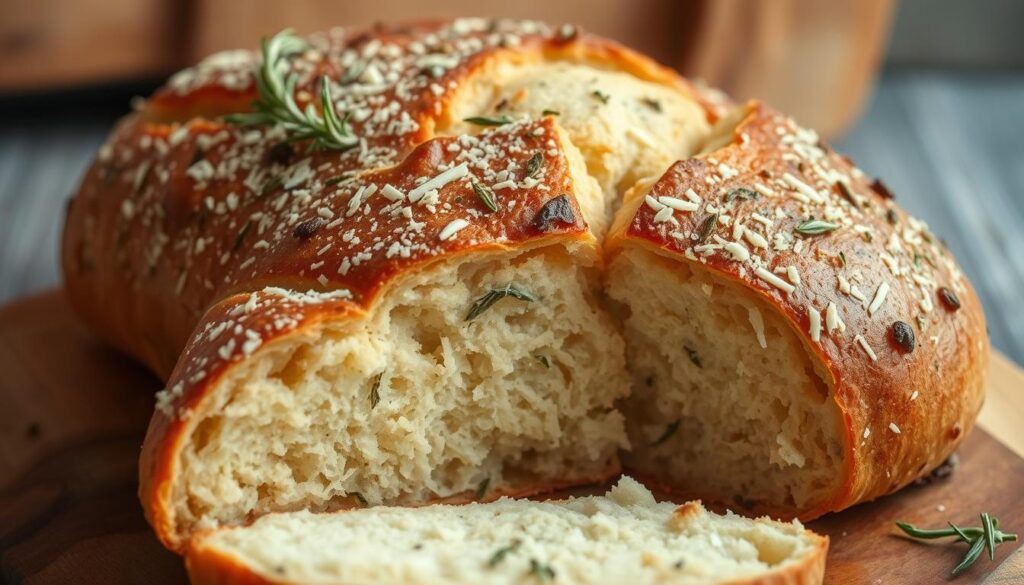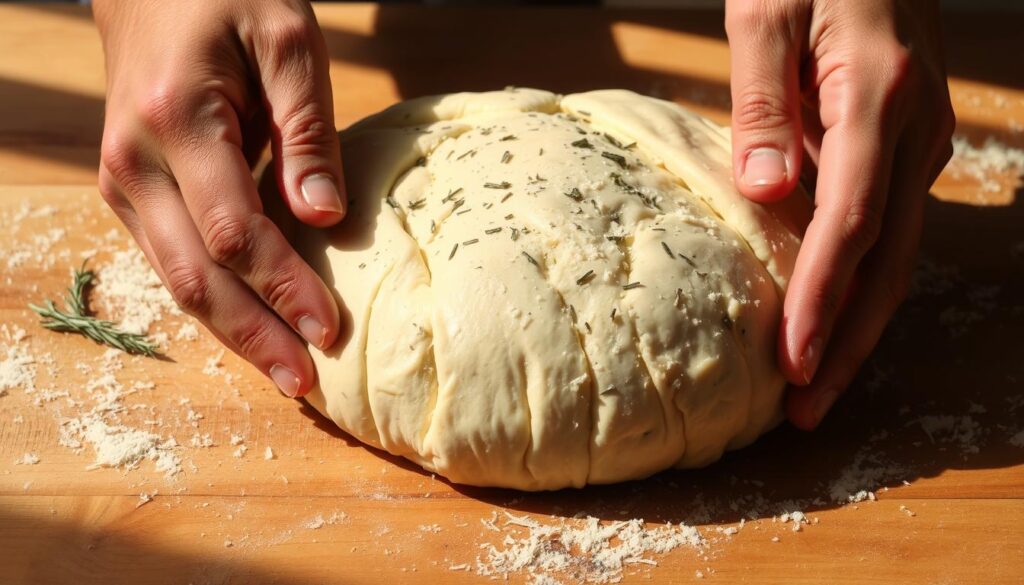
Are you searching for the ultimate rosemary parmesan bread recipe? As someone who loves bread, you want something tasty and simple. Making artisan bread is an art. It mixes basic ingredients with skill to make amazing loaves.
Rosemary and parmesan cheese add a special touch to homemade bread. With a homemade bread recipe, your kitchen will fill with the scent of fresh bread. We aim to help you make a rosemary parmesan bread that will wow everyone.
Table of Contents
The Art of Homemade Herb Bread
Perfecting homemade herb bread is a journey into the world of artisan bread-making. It’s not just about following a recipe. It’s about mastering techniques that make your baking stand out.
Homemade herb bread, like the rosemary and parmesan version, is special. It combines aromatic herbs and savory cheese in a unique way. This mix not only delights your taste buds but also fills your kitchen with a wonderful aroma.
Why This Recipe Stands Out
This rosemary parmesan bread recipe uses fresh, high-quality ingredients. It has a special process that makes the crust perfect and the inside soft. The rosemary adds a piney flavor, while parmesan brings a salty, umami taste that balances the bread’s sweetness.
| Feature | Benefit |
|---|---|
| Fresh Rosemary | Aromatic flavor |
| High-Quality Parmesan | Savory, umami taste |
| Artisan Techniques | Perfect crust and soft interior |
What to Expect from This Artisan Loaf
Baking this artisan loaf will give you a bread that’s both delicious and beautiful. The rosemary and parmesan topping make a beautiful, rustic crust. It’s great for serving at gatherings or enjoying with a simple meal.
Essential Ingredients for Rosemary Parmesan Bread
Let’s explore the key ingredients for our rosemary parmesan bread. The quality and type of ingredients greatly affect the bread’s taste and texture.
Flour Selection and Alternatives
The base of any bread is its flour. For our rosemary parmesan bread, use high-protein bread flour for a chewier crumb. All-purpose flour works too if you don’t have bread flour. For gluten-free options, a blend is available but the texture might differ.
Tip: Choose unbleached, unbromated bread flour for the best results.
Choosing the Right Parmesan Cheese
Parmesan cheese brings a salty, umami taste to the bread. Go for high-quality, aged Parmigiano-Reggiano for the best flavor. Grate it yourself for freshness or use pre-grated if you’re in a hurry. Freshly grated cheese tastes more vibrant.
Fresh vs. Dried Rosemary
Rosemary is crucial for this bread, adding a piney flavor. You can use fresh or dried rosemary, depending on what you prefer. Fresh rosemary has a milder taste, while dried is stronger. Chop fresh rosemary finely to spread the flavor evenly.
Other Key Ingredients
Other must-haves include salt, sugar, yeast, and olive oil. Use flaky sea salt or kosher salt for the best taste. Active dry yeast is easy to use and reliable. Olive oil adds moisture and richness to the bread.
Remember: The quality of your ingredients greatly impacts the final product, so choose wisely.
Equipment and Preparation
To make bread smoothly, you need the right tools and prep. Rosemary parmesan bread needs specific gear for the perfect loaf.
Essential Baking Tools
You’ll need some essential baking tools to start. You’ll need a big mixing bowl, a measuring cup and spoons, and a wooden spoon or dough whisk. Also, a baking sheet or bread stone is needed for baking. A dough scraper or pastry cloth helps with the dough. Quality tools make the process fun and improve your bread.
Preparing Your Workspace
Before starting, prepare your workspace well. Clear a big area for mixing and kneading. Make sure your surfaces are clean and lightly floured to avoid dough sticking. Keep all ingredients and tools close to make the process smoother. Having a trash bin nearby helps with waste. By organizing your workspace well, you can focus on making your rosemary parmesan bread.
The Ultimate Rosemary Parmesan Bread Recipe
Get ready to make the perfect rosemary parmesan bread at home. Baking bread is a fun and rewarding hobby. With this guide, you can make bread that looks and tastes like it came from a bakery.
Making the Perfect Dough
To begin, mix 2 cups of warm water, 2 teaspoons of sugar, and 1 teaspoon of yeast in a big bowl. Wait 5-10 minutes for it to get frothy. Then, add 3 cups of flour, 1 teaspoon of salt, and 1 tablespoon of olive oil. Mix until it’s a shaggy dough.
Knead the dough on a floured surface for 10 minutes. It should become smooth and elastic. You can also use a stand mixer with a dough hook for easier kneading.
First Rise and Folding Techniques
Put the dough in a lightly oiled bowl, cover it, and let it rise in a warm place for 1 hour. It should double in size. Then, fold the dough several times to strengthen it. Rotate the bowl as you fold.

Incorporating Rosemary and Parmesan
After the first rise, mix in 2 tablespoons of chopped rosemary and 1/2 cup of grated parmesan. Make sure they’re spread out evenly for a balanced flavor.
Shaping and Second Rise
Shape the dough into a round or oblong loaf. Place it on a baking sheet lined with parchment paper. Cover it and let it rise for 30-45 minutes. This second rise makes the bread lighter.
Baking to Golden Perfection
Preheat your oven to 425°F (220°C). Bake the bread for 25-30 minutes. It should be golden brown and sound hollow when tapped. Let it cool before slicing.
| Ingredient | Quantity | Purpose |
|---|---|---|
| Flour | 3 cups | Provides structure |
| Rosemary | 2 tablespoons | Adds herbal flavor |
| Parmesan Cheese | 1/2 cup | Adds savory flavor |
Troubleshooting and Tips for Success
With a few simple adjustments and tips, you can make delicious rosemary parmesan bread every time. Mastering bread making means knowing common mistakes and how to fix them.
Common Bread-Making Mistakes
One big mistake is overmixing the dough, which makes it dense. Mix ingredients just until they come together, then rest the dough. Not letting the dough rise enough can also make it flat or dense. Make sure it rises in a warm, draft-free place.
Tip: Always check your yeast’s freshness before starting. Old yeast can stop your bread from rising.
Adjusting for Different Climates
Climate affects your bread making a lot. In dry climates, add more water to the dough. In humid ones, use less. Temperature also matters; warmer places make dough rise faster, cooler ones slower.
Adjusting your recipe for your climate helps get consistent results.
Variations and Flavor Combinations
Don’t be shy to try new flavors and ingredients. Swap rosemary for thyme or oregano for a different taste. Add garlic, olives, or sun-dried tomatoes for unique flavors.
Trying different variations keeps bread making fun and matches your taste. These tips and adjustments help both beginners and experienced bakers succeed.
Conclusion: Enjoying Your Freshly Baked Bread
Now that you’ve baked your rosemary parmesan bread, it’s time to enjoy it. Take in the aroma and taste of your fresh loaf. You can enjoy it on its own or with your favorite meal.
Slice it up and serve it with soups, salads, or pasta. Sharing rosemary parmesan bread with others makes it a great gift. It’s perfect for friends and family.
As you keep making bread, trying new recipes and techniques, you’ll love it more. Enjoying homemade bread becomes a special ritual. So, take a bite and enjoy the joy of making something delicious from scratch.





